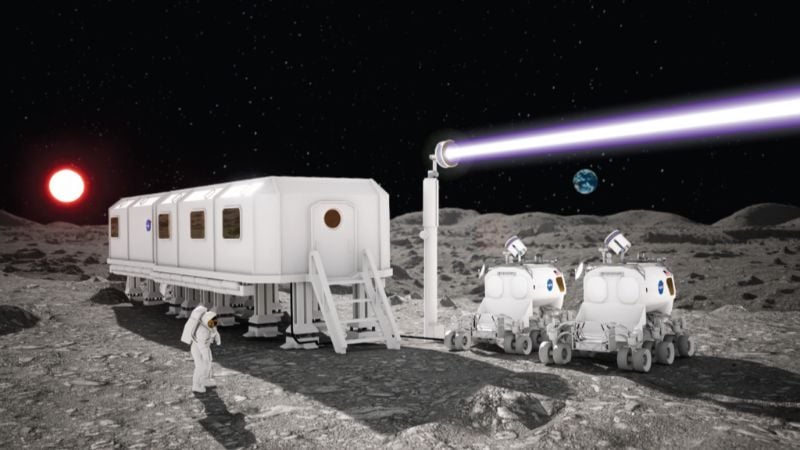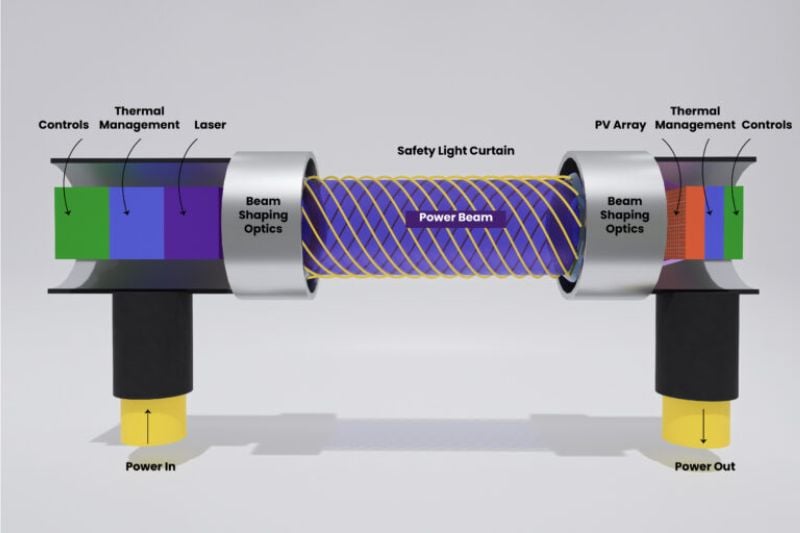Laser-Beaming Moon Light Created for Lunar Power Grid
Jeff Bezos’ Blue Origin and PowerLight have developed a laser-operated power-beaming system that could provide electricity on the Moon. PowerLight’s chief technology officer talked with EEPower about the device.
The Defense Advanced Research Projects Agency (DARPA) has initiated a 10-year lunar architecture capability study called LunA-10 to explore technology concepts for identifying risks and accelerating commercial solutions for a future lunar economy. For the study, DARPA selected 14 industry teams to receive up to $1 million each for studies advancing lunar infrastructure over the coming decade. The results of these initial study projects are due this spring.
One grant recipient is a team combining PowerLight Technologies with Jeff Bezos’ Blue Origin space venture. The companies will design a laser-operated power-beaming system to distribute electric power to remote locations on the lunar surface.
Concept for moon light. Image used courtesy of PowerLight Technologies
Power Anywhere on the Moon
Tom Nugent, PowerLight Technologies’ co-founder and chief technology officer, told EEPower, “To live and work on the Moon, we’ll need reliable access to energy. Although NASA and DARPA are working with industry players to develop power generation systems designed for supporting longer stays on the lunar surface, additional infrastructure to distribute that power will be needed to make operations on the Moon a reality.”
Washington state-based PowerLight was formed in 2007 (originally called LaserMotive) to develop laser-powered energy transmission systems. The company has developed systems for reliably transmitting electrical power over the air and through fiber optic cables. The systems have terrestrial applications such as powering drones in flight or providing electricity to remote land and undersea locations.
How PowerLight Electricity Transmission Works
Nugent explained how the PowerLight’s transmission system works.
“Laser power beaming is a system for distributing power from a source location to a desired consumption location using only light as the transfer medium.”
Lasers are used to convert electric power into light, and photovoltaic (PV) cells convert the light energy back to electricity.
“Both technologies have benefited from market dynamics over the last two decades that have increased performance and reduced cost by orders of magnitude,” Nugent added.
PowerLight Free Space power beaming technology. Image used courtesy of PowerLight Technologies
PowerLight’s’ system consists of a power-beaming transmitter at the source power location and a power-beaming receiver at the desired power consumption location. Power can be beamed long-distance (tens to hundreds of kilometers in space) in free space on a line-of-sight basis. It can also be transmitted inside a lightweight fiber optic cable. The transmitter will include both coarse and fine pointing and tracking systems. It also has optical and optomechanical assemblies for shaping and pointing the optical beam for transmission across distances.
The receiver is made from an array of photovoltaic cells selected for optimized conversion of the optical beam to electricity. It includes the optical and opto-mechanical assemblies necessary to receive the beam and deliver it to the photovoltaics in a way that maximizes conversion efficiency. The receiver includes the aiming necessary for system connectivity. Electrical DC regulators convert the output from the photovoltaic cells into usable electric power. A thermal management subsystem manages the waste heat generated by the conversion process.
The system includes end-to-end, comprehensive laser safety technology and hardware and software elements that manage reflected or misdirected light, proximity incursions, beam intrusions, and system malfunctions. This is part of the primary control system commanding and monitoring all subsystems and performance data while also enabling remote control and data acquisition.
Powering Moon-Based Communities
Developing a lunar power grid will present challenges, and there is a strong consensus among DARPA and NASA researchers that building items like solar panels from materials found on the moon will be the most economical and effective way to develop lunar communities. This will require considerable power and might need to be located remotely from any habitation outpost to minimize induced contamination from dust generation during plant operations. Electricity will need to be distributed over long distances to power communications systems and mobile rovers. Power may also need to be transmitted deep into shadowed regions in craters—regions thought to contain vast amounts of frozen water.
Power for Remote Earth-Based Needs
Back on Earth, PowerLight has already demonstrated beamed power for telecommunication systems through fiber optic cables and is working on a different DARPA project to build an airborne system to provide long-range energy for high-altitude for global military operations, such as powering high-altitude airborne drones. The company is also looking at power transmission to places like sub-Saharan Africa, where traditional electric power grids are not practical.
Video used courtesy of U.S. Naval Research Laboratory
Future of LunA-10
For now, DARPA’s LunA-10 study is looking for companies with a clear and technically rigorous business plan for providing or using a variety of lunar services. The goal is to use collaborative efforts to develop a viable infrastructure for the moon by 2035. Energy transmission and communications are the cornerstones of such an infrastructure, and PowerLight appears ready to accept the coming challenges.








